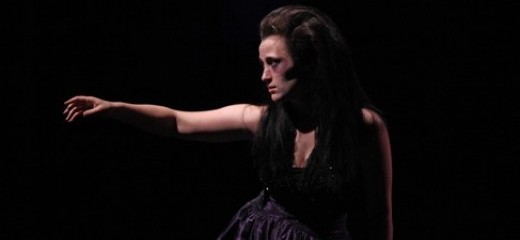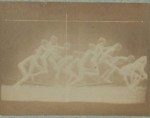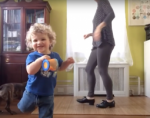
Photo: Bill Hebert
Strangers in Artsland: Three “Newbies” Reflect on Philadelphia
By Lynn Matluck Brooks
[
Pictured on homepage: Tori Lawrence; above: Kelly Turner]
Philadelphia has a lively performing arts scene, fueled by a few large established companies and ensembles, “fringe” and “lab” opportunities, and festivals and arts coops. Yet its renown as an arts city is far below that of such capitals as New York, Paris, or Berlin. Why are artists—choreographers, dancers, directors, filmmakers, and other performers and creators—drawn to Philadelphia? What kind of reception do they encounter when they arrive here to set up shop? Which challenges prove most daunting? Do they find community in the City of Brotherly Love? These questions and others motivated me to contact three movement artists—Nikki Appino, Tori Lawrence, and Kelly Turner—attempting to establish and nurture their careers in Philly.
These artists came from diverse corners of the country and the arts world before landing in Philadelphia. Appino, documentary filmmaker and director of generative theater that is strongly movement-based, was raised in Philadelphia, but her professional development and career unfolded in New York City and Seattle. She moved back to Philadelphia, with few contacts or prospects, just over a year ago. Lawrence, choreographer and director of Tori Lawrence + Co., grew up in Atlanta, Georgia, attended Franklin & Marshall College in Lancaster, Pennsylvania, (where I was one of her teachers) and, upon graduation two years ago, moved to Philadelphia. Turner, from Connecticut (and, later, Nebraska), graduated from the University of the Arts in 2009, after which she chose to remain in Philadelphia and established herself as director of Choreosplat Dance Works.
.jpg)
Nikki Appino in Thailand. Photo: Sumon Unsathit
Both Lawrence and Appino were drawn to the city because of the nature of its places and people. Appino found Philly’s edgy but emerging neighborhoods tempting to invest in for establishing art-making spaces and activity. Investing her savings, she purchased two warehouses in Brewerytown—a somewhat struggling neighborhood in north Philly—that she is converting into living, working, and studio rental spaces, employing local workmen and getting to know her neighbors in the course of the project—her first creative venture in the city. She’s found Philly’s folk to be “straightforward” and “real” as opposed to the egos and passions of New Yorkers. Lawrence, too, “fell in love with the rich history and landscape” of Philadelphia, the “hidden gems” of “urban decay” that have inspired her architecturally grounded work. And, she’d heard from a couple of college friends who settled there that the city had a “supportive arts community.” For Turner, who had worked at nEW Festival (
http://newfestival.blogspot.com/) and at SCRAP Performance Group (
http://www.myradance.org/scrap.htm), the work and people she encountered in those exposures resolved her commitment to making her artistic life in Philly. Although all of these artists arrived with few or no contacts, they sensed the supportive nature of the dance and arts people and continue to make their ways, slowly, from one preliminary connection to another, building their own community.
Appino found Philly’s arts people generous and accessible. Craig Peterson, director of the Live Arts Brewery (
http://www.livearts-fringe.org/lab/index.cfm), for example, promptly offered the newly arrived artist workspace and also housed a workshop for her new piece. Turner, too, felt the earlier portion of her life in the city was smooth, but she has found that attempting to sustain her career there is more of a challenge. Lawrence, on the other hand, had a lonely time for her initial few months, but then the good fortune of becoming an artist-in-residence at Mascher Space Cooperative (
http://mascherdance.com) gave her access to artists familiar with the city who shared her creative objectives. People like Marcel Williams Foster, a longer-established artist-in-residence there, have helped Lawrence make connections and find opportunities for her work.
As critically important as community is to artists, the fact remains that art costs money. Making their ways into the world of Philadelphia arts funding remains a challenge for these three: identifying funding avenues, grants opportunities, and financial support seems the most pressing challenge. Is the artist’s life in Philadelphia financially sustainable? That remains the big question for these newbies and—I imagine—for not-so-newbies as well. With places like New York proving so stressful and unaffordable for artists, smaller cities like Philly—with its access to large population bases up and down the coast and more modest cost of living—seem appealing. Yet all three of these artists are still in a wait-and-see mode regarding the feasibility of realizing their career and life goals in the city.
After their initial periods of residence and work in Philadelphia, how would these artists describe themselves? Appino is still establishing herself as a space-owner, an arts generator, a filmmaker, and—with considerably more difficulty—a theater director. Lawrence finds herself still very much the new gal on the dance block, scrambling to be seen, to draw audience, to compete for funding. Turner, with the longest continuous period of time in the city, self-describes as an “accepted newbie”; people are open and generous, but she doesn’t feel she’s gotten the recognition and acceptance that mark more established groups and artists. Getting noticed by what all regard as the generous, diverse, close-knit world of Philadelphia artists can—despite those positive ascriptions—be difficult. Getting reviews, as well, can be a frustration for Turner. She acknowledges, though, that her work does get presented and, in light of receiving the 2011 Rocky Award for her piece "What's Been Done," recognized. Lawrence has dived energetically into marketing with some good results, garnering critical attention in CRED magazine, the Philadelphia Inquirer, WHYY Newsworks, ThinkingDance.net, and elsewhere. Will these exposures afford her work wider visibility in Philadelphia? —and beyond? That’s the goal, but the climb appears steep.
The city’s hardworking, entrepreneurial spirit, its supportive yet modest nature, and its established and bubbling arts scene have allowed these artists to strike some sparks. Will they take flame? Keep watching.
By Lynn Matluck Brooks
July 26, 2012

.jpg)






.png)


